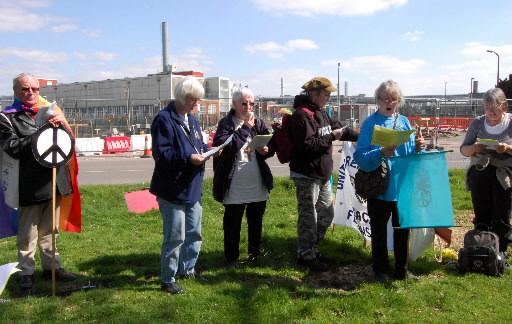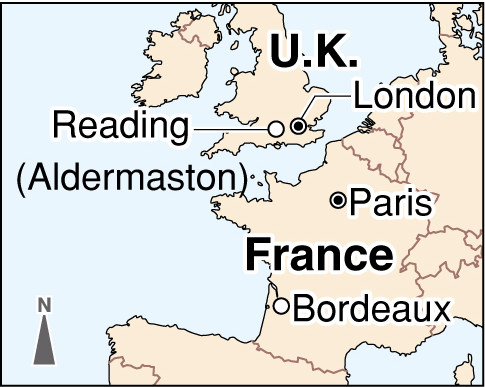Nuclear weapons can be eliminated: Chapter 5, Part 3
Jul. 21, 2009
Chapter 5: Unseen targets in the U.K. and France
Part 3: Laser fusion
by Yumi Kanazaki, Staff Writer
Design of warheads without nuclear testing
With its streets lined with brick houses, the town of Reading, England, 70 kilometers west of London, seems like something out of a storybook. But when I left the center of town and came to the top of a rise in the woods, a strange scene suddenly appeared.
Surrounded by several barbed wire fences, it was the Aldermaston Atomic Weapons Establishment (AWE). Along with AWE Burghfield, located just a few kilometers away, it carries out the research, development, assembly, and quality control of the warheads deployed on Trident missiles.
“There’s a construction boom going on in there. They’re building a laser facility for simulating nuclear explosions and other things,” said Givria Gigliotti with a frown as she stood outside the barbed wire. Gigliotti is a member of the Aldermaston Women’s Peace Camp. For 23 years the group of about 10 local women has camped out monthly to monitor the AWE facility.
Aldermaston was originally a Royal Air Force base. In 1950 it became the site of the U.K.’s nuclear weapons research and development. It is now operated by Lockheed Martin Corp., another U.S. company and a British company under a contract with the British Defense Ministry. A modified version of the U.S. W76 nuclear warhead is believed to be maintained there.
Ms. Gigliotti pointed in the direction of a huge building: a laser fusion facility. Several countries are competing to develop and put into use this “sun on the earth,” which produces nuclear fusion experimentally, as the next-generation power generation technology, along with other functions. In the field of nuclear weapons development, this technology could be used to confirm the safety and reliability of stockpiled nuclear warheads and would make possible the design of nuclear warheads without conducting tests.
In 1998, along with France, the U.K. became one of the first nuclear nations to ratify the Comprehensive Test Ban Treaty (CTBT). If this new facility is put into operation, nuclear development could be carried out while still conforming to the provisions of the treaty.
According to AWE, the facility is scheduled for completion in 2010. The total cost is projected to be £183 million (28.7 billion yen). Chris Gidden, 63, is a member of the Campaign for Nuclear Disarmament (CND), an anti-nuclear group whose 50 members conducted a demonstration outside the facility’s fences. “Rather than spending a huge amount of money to maintain nuclear weapons, they should scrap the warheads,” she said.
Across the Strait of Dover in France, a laser nuclear fusion facility is under construction on the outskirts of Bordeaux in western France. In Paris I met Dominique Lalanne, 65, a nuclear physicist who has worked at the National Center for Scientific Research (CNRS). He is the coordinator for Abolition 2000, a movement promoting the abolition of nuclear weapons. “The situation is the same here,” he said with a nod. “We need to look not only at the number of nuclear warheads but also the enhancement of their development and capability.”
The U.S., which got into the field first, recently completed a laser fusion facility at the Lawrence Livermore National Laboratory in California, the site of the country’s nuclear weapons development. The development of technology and the creation of a system that will lead to more sophisticated nuclear development are proceeding steadily on a global scale.
(Originally published on June 23, 2009)
To comment on this article, please click the link below. Comments will be moderated and posted in a timely fashion. Comments may also appear in the Chugoku Shimbun newspaper.









